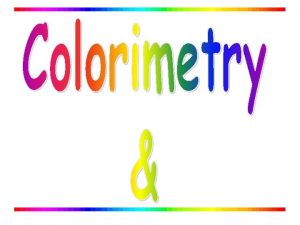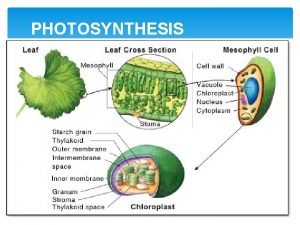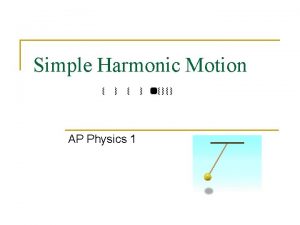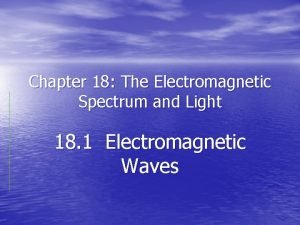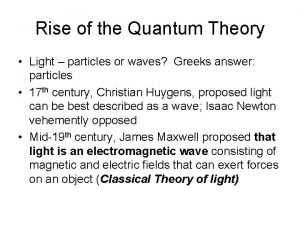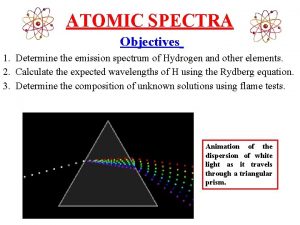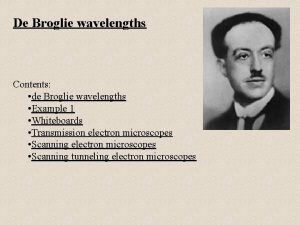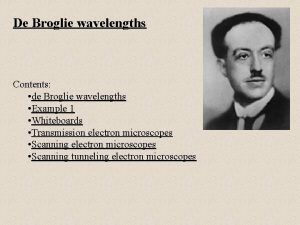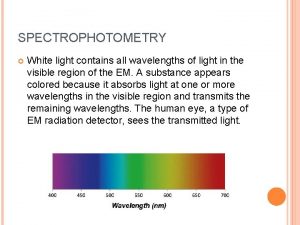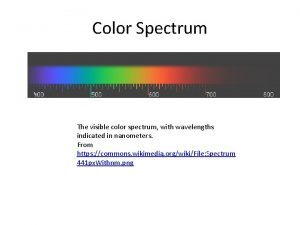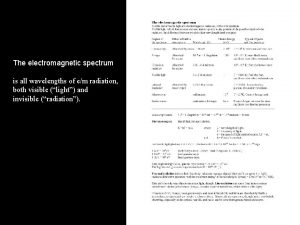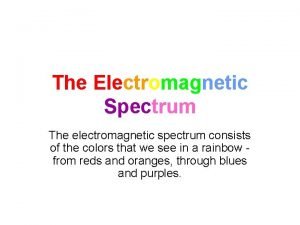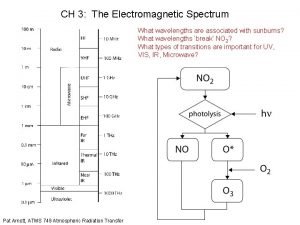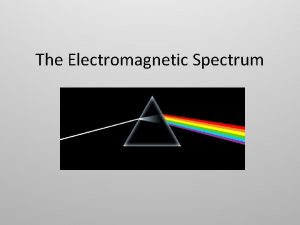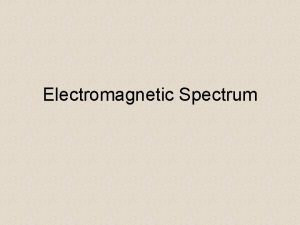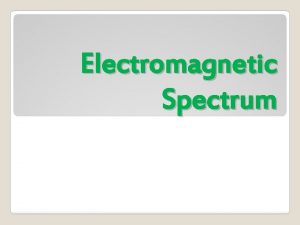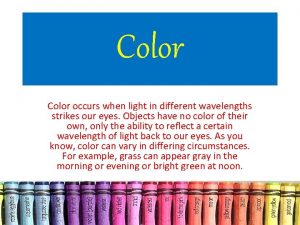LIGHT The spectrum consists of all wavelengths of












































- Slides: 44

LIGHT

The spectrum consists of all wavelengths of electromagnetic energy. Visible light is only a small portion of this spectrum. The range of visible light consists of wavelengths between about 0. 4 microns (blue) to 0. 7 microns (red).

Normally light travels in a straight line. Here a light source shines through slits cut in a piece of paper.

If a light wave is incident upon the interface of a more dense transparent Medium at a 90 degree angle ( normal to the interface) the wave will slow down, but it will still go straight through the medium and speed up again when it leaves the other side.

However, if a light wave is incident upon the interface of a more dense medium at some angle other than 90 degrees, the wave will slow down and change directions. It will also speed up again and change directions again when it leaves the new medium. This change in direction is called Refraction.

To understand how refraction takes place, imagine the wave crests of a single light wave as lines. In this case, as the wave enters the Interface between the lower and higher density media, the Top of the wave slows down first. This “pulls” the wave towards the slower edge and causes the wave to change directions.

Remember our beams of light? If we place a piece of glass with a curved surface into the beams…

The light waves, and therefore the beams, will be refracted. Only the waves that strike the very center of the glass lens will strike normal to the surface and travel straight through. This is a bi-concave lens. It diverges the beams ( spreads them apart).

This picture shows a Plano-convex lens. Note how the lens converges the beams to a point (focal point). This lens is sometimes called a converging lens.

Here a beam of light strikes a mirror at about a 45 degree angle from the normal. Note that the angle of incidence and the angle of reflection are the same. Angle R=Angle I

Here a laser beam reflects from the surface of a mirror. Note that the angle of reflection and the angle of incidence are the same. Both angles are measured from the normal line to the respective beam.

Here a laser projects a beam of light into the end of a curved Lucite rod. Because the inner surface of the plastic rod reflects most of the light, the laser light goes around the curve and shines out the opposite end of the rod!

On closer examination you can actually see the laser beam reflecting off of the inner surface of the solid plastic rod! The process at work here is called internal reflection. This is the basic concept behind fiber optics technology.

Recall that visible light is a mixture of all the wavelengths of Light “ROYGBIV”. Each color is a different wavelength. (*Red is longest & violet is the shortest visible wavelength. )

Why is the red car red?

Because even though ALL the wavelengths of visible white light may be incident upon the surface, you see only the red wavelengths of light reflected from the car. All the other wavelengths are absorbed by the pigments ( coloring agents) in the paint.

So, what color would the car appear if you looked at it through a blue plastic filter? ( Hint: remember the car reflects only red wavelengths while the blue filter transmits only blue wavelengths and absorbs all others. )

Of course the car appears black because the blue filter blocks the red wavelengths reflected from the car and the car reflects no blue wavelengths!

So, how about if we look at a blue car through a red filter? What color will the car appear?

If you said black you were right. Even though all the wavelengths of visible white light strike the car’s surface, only the blue wavelengths are reflected by the pigments in the paint. Since the blue wavelengths are blocked by the red filter, no light waves from the car can reach your eyes, so the car looks black!

This is a gas discharge tube filled with Neon gas. When the electrons are excited by the electric current, they jump to a higher energy level. When they fall back down, they give up a distinctive series of spectrum lines that can be used to identify Neon.

A spectroscope can be used to look at the spectrum emitted by the excited atoms of gas in the tube.

Here you can see the spectrum of Neon through the spectroscope.

Here a piece Nichrome wire is coiled and connected to a low Voltage power source. When electricity passes through the wire gets hot. The electrons in the wires atoms jump up to higher energy levels…

…and when they fall back down they give the energy up as heat and light. This process is called incandescence. This is how light is produced in light bulbs. Notice that the wire first glows red then as the electric current is increased it turns yellow…it’s moving up the spectrum!

This clear light bulb can show incandescence works.

Inside the light bulb is a thin coiled wire filament made of tungsten.

When current is passed through the filament it starts to glow. As the current is increased…

…it glows brighter and brighter…INCANDESCENCE!!!! We now have an incandescent light bulb.

Here is how INCANDESCENCE takes place. 1. An electron is excited by absorbing heat from electrical resistance. 2. The excited electron jumps higher. 3. The excited electron falls back down and gives off the energy as LIGHT. I guess this means that incandescent bulbs change electricity into heat and light!

Here are two plastic light filters. They look like the plastic sunglasses are made of. Light goes through both of them.

Now turn one filter ¼ turn you can see that light does NOT go through the two filters. WHY?

To understand why you must think of light as a wave that vibrates both horizontally and vertically, like these two waves made of wire.

The molecules in the filters are aligned parallel to each other. If they are held so that the molecules in both filters are vertical, the vertical vibrations of light can get through, but the horizontal Vibrations can not. The resulting light, that vibrates in one dimension only, is called “POLARIZED” light.

If one filter is turned ¼ turn, the light that is polarized by the first filter will not pass through. This is why the two filters together blocked the light.

Here are the two wire waves. They represent unpolarized light striking a flat vertical surface. Notice that the light is vibrating vertically and horizontally…

…but when it reflects from the surface, the horizontal vibrations have either been absorbed by the surface or changed to vertical vibrations. The surface produces polarized light! This polarized light reflected from a surface is called GLARE.

Click on the picture and you can see how a polarizing lens blocks glare from a surface.

The little man glows when placed near a black light. This is called FLUORESCENCE.

Fluorescence happens when the atoms in the little figure take in UV ( ULTRA VIOLET ) light and change it to visible light.

If you look carefully, you can see the spectrum produced by the prism in the foreground.

From above the prism, you can see that the “white light” beam is refracted by the prism.

The prism refracts the shorter wavelengths of light, the ones towards The blue end of the spectrum, more than the longer wavelengths. Thus, a prism sorts light by each colors distinctive wavelength.

The End
 Emr spectrum
Emr spectrum Light light light chapter 23
Light light light chapter 23 Into the light chapter 22
Into the light chapter 22 Light light light chapter 22
Light light light chapter 22 Copper orbital diagram
Copper orbital diagram Absorption spectrum vs emission spectrum
Absorption spectrum vs emission spectrum Absorbance = abc
Absorbance = abc The gel-filled space inside the chloroplast
The gel-filled space inside the chloroplast Work and energy
Work and energy A slingshot consists of a light leather cup
A slingshot consists of a light leather cup Motion simple definition
Motion simple definition A slingshot consists of a light leather cup
A slingshot consists of a light leather cup Name a line containing point a
Name a line containing point a Chapter 18 the electromagnetic spectrum and light
Chapter 18 the electromagnetic spectrum and light Light spectrum
Light spectrum Spectrum white light
Spectrum white light Pure spectrum of light
Pure spectrum of light An attachment plug establishes connection between
An attachment plug establishes connection between Put out that light
Put out that light Membrane bound organelles
Membrane bound organelles The bouncing off of light.
The bouncing off of light. Things that can block light
Things that can block light Hình ảnh bộ gõ cơ thể búng tay
Hình ảnh bộ gõ cơ thể búng tay Ng-html
Ng-html Bổ thể
Bổ thể Tỉ lệ cơ thể trẻ em
Tỉ lệ cơ thể trẻ em Chó sói
Chó sói Chụp phim tư thế worms-breton
Chụp phim tư thế worms-breton Bài hát chúa yêu trần thế alleluia
Bài hát chúa yêu trần thế alleluia Môn thể thao bắt đầu bằng từ chạy
Môn thể thao bắt đầu bằng từ chạy Thế nào là hệ số cao nhất
Thế nào là hệ số cao nhất Các châu lục và đại dương trên thế giới
Các châu lục và đại dương trên thế giới Cong thức tính động năng
Cong thức tính động năng Trời xanh đây là của chúng ta thể thơ
Trời xanh đây là của chúng ta thể thơ Mật thư anh em như thể tay chân
Mật thư anh em như thể tay chân Làm thế nào để 102-1=99
Làm thế nào để 102-1=99 độ dài liên kết
độ dài liên kết Các châu lục và đại dương trên thế giới
Các châu lục và đại dương trên thế giới Thơ thất ngôn tứ tuyệt đường luật
Thơ thất ngôn tứ tuyệt đường luật Quá trình desamine hóa có thể tạo ra
Quá trình desamine hóa có thể tạo ra Một số thể thơ truyền thống
Một số thể thơ truyền thống Cái miệng nó xinh thế chỉ nói điều hay thôi
Cái miệng nó xinh thế chỉ nói điều hay thôi Vẽ hình chiếu vuông góc của vật thể sau
Vẽ hình chiếu vuông góc của vật thể sau Biện pháp chống mỏi cơ
Biện pháp chống mỏi cơ đặc điểm cơ thể của người tối cổ
đặc điểm cơ thể của người tối cổ






